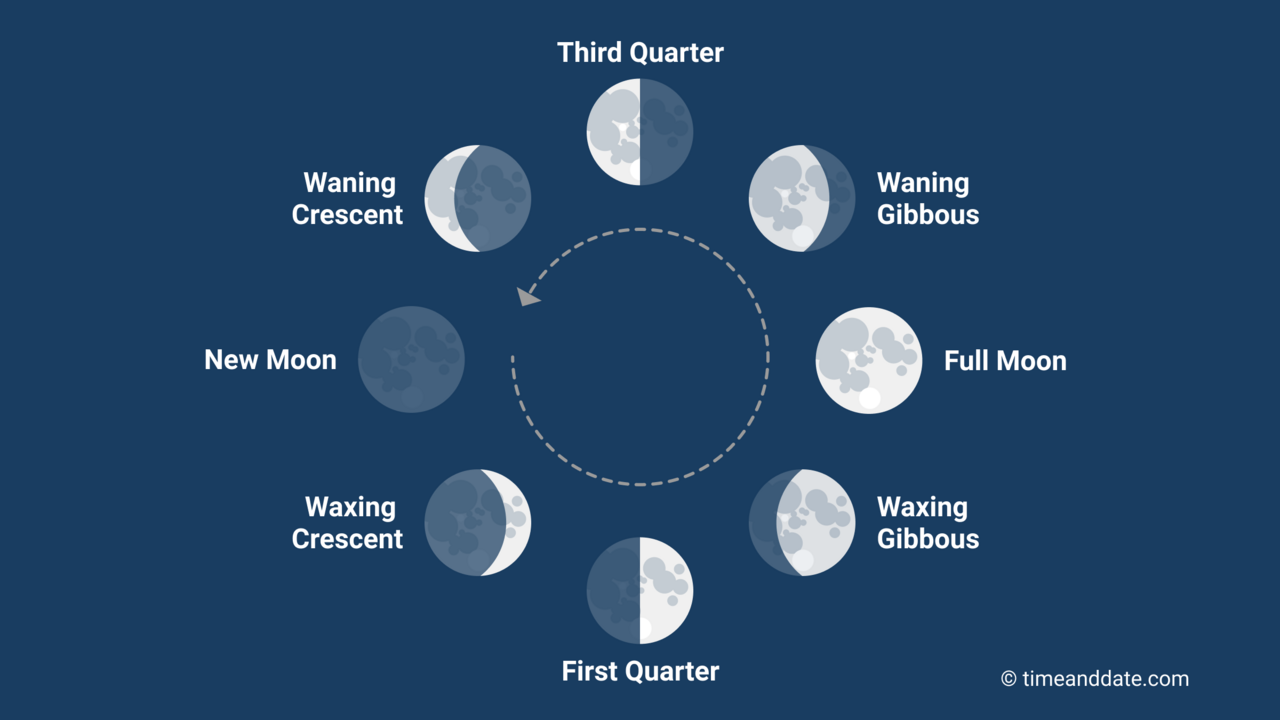Waning Crescent Moon
This intermediate Moon phase is the last phase of the lunar month. It starts just after the Third Quarter Moon and lasts until the following New Moon.

The Waning Crescent Moon has a sickle shape.
©iStockphoto.com/davidhoffmannphotography
Where on the Moon is the South Pole?
Next Waning Crescent Moon
Starts: Dec 11, 2025 at 3:51 pm
Ends: Dec 19, 2025 at 8:43 pm
Times for the Waning Crescent Moon vary by time zone. Times and dates are based on the local time in Columbus. Change location
With some variations, the Waning Crescent Moon rises after midnight and is still up and visible in the morning and day sky before it sets in the afternoon.
A Waning Moon Shrinks
During the Waning Crescent Moon phase, the lit-up part of the Moon’s face decreases from about 50% to 0%. The phase lasts from the Third Quarter Moon’s semicircle until it disappears from view at New Moon.
Waning means that it’s shrinking and getting smaller, while crescent refers to the curved sickle shape.
The Moon’s surface reflects the Sun’s rays, and half of it is always illuminated by sunlight. Just how much of that light we can see from Earth varies every day, and we refer to this as a Moon phase.
The Moon: Our natural satellite
Earthshine Is Reflected Sunlight
Although only a small part of the Moon’s face is directly illuminated by the Sun at the end of the Waning Crescent Moon phase, the rest of the Moon is sometimes also faintly visible. The reason is that Earth reflects sunlight as a faint glow onto the Moon. This phenomenon is called earthshine or the Da Vinci glow, and it is most noticeable in April and May.

A Waning Crescent Moon with earthshine, and the planet Venus close by.
©iStockphoto.com/shaunl
Spot Venus Close By
Venus, the third brightest object in the night sky, after the Sun and the Moon, can often be found next to the Crescent Moon. When seen in the mornings, as the morning star, it is close to the Waning Moon. When it is seen in the evenings, as the evening star, it is close to the Waxing Crescent Moon.
All the planets, including Earth, more or less orbit around the Sun on the same imaginary plane in the sky, known as the ecliptic, so they sometimes meet in the sky.


It takes around 29.5 days to move through the eight Moon phases.
©timeanddate.com
Lunar Month: A Repeating Cycle
In western culture, we divide the lunar month into four primary and four intermediate Moon phases.
The Moon phases start with the invisible New Moon, while the first visible phase is the thin sliver of a Waxing Crescent Moon. Around a week later, half of the Moon’s visible surface is illuminated while the other half is in darkness at First Quarter Moon.
The illuminated part continues to grow into a Waxing Gibbous Moon, until 14–15 days into the cycle, we see the entire face of the Moon lit up at Full Moon.
The illuminated part then gradually shrinks into a Waning Gibbous Moon, and when it reaches the Third Quarter, the opposite half from the First Quarter is illuminated. From there, it fades into the Waning Crescent Moon before it finally disappears from view again, only to reemerge and repeat this cycle over and over.
Looks Different Around the Globe
The Moon phases are the same all over the world, both in the Northern and Southern Hemispheres. The same percentage and area of the Moon will be lit up no matter where on Earth you are.
The orientation of Waning Crescent Moon depends on the time, the date, your location, and the Moon’s position in the sky. Exactly where the lit up part of the Moon appears—the top, bottom, or the side—also depends on how high the Moon is in the sky.
Is the Moon upside-down in the other hemisphere?
The line, or curve, dividing the illuminated and dark parts of the Moon is called the terminator. The terminator of a Waning Crescent Moon can appear on the right side, the left, the top, or the bottom.
Sleep, crime, and menstruation: how Moon phases affect humans
No Crescent Moon in Calendars
There is no symbol for a Waning Crescent Moon in calendars as it is an intermediate Moon phase. Only the four primary phases are shown in calendars with the following symbols:= New Moon
= First Quarter
= Full Moon
= Third Quarter
The Moon illustration on our Moon phase pages changes as time passes and indicates more accurately, although not perfectly, the orientation of the illuminated part of the Moon.